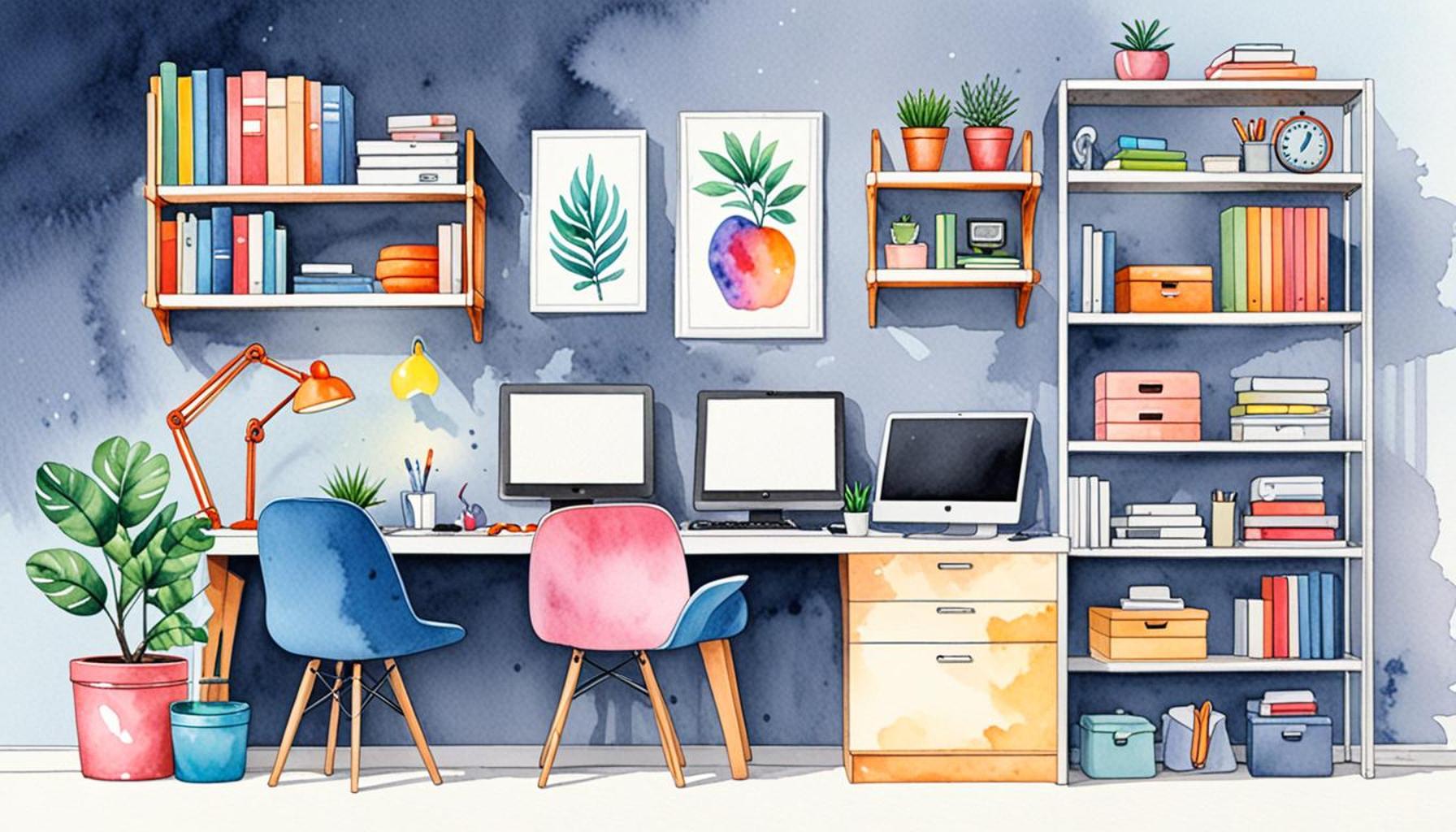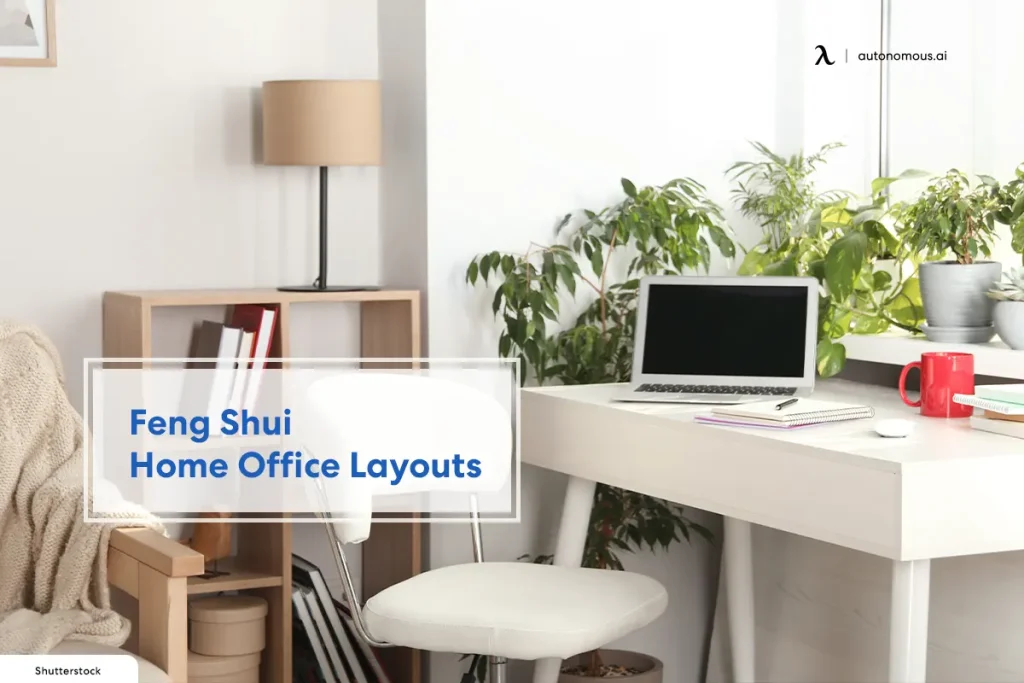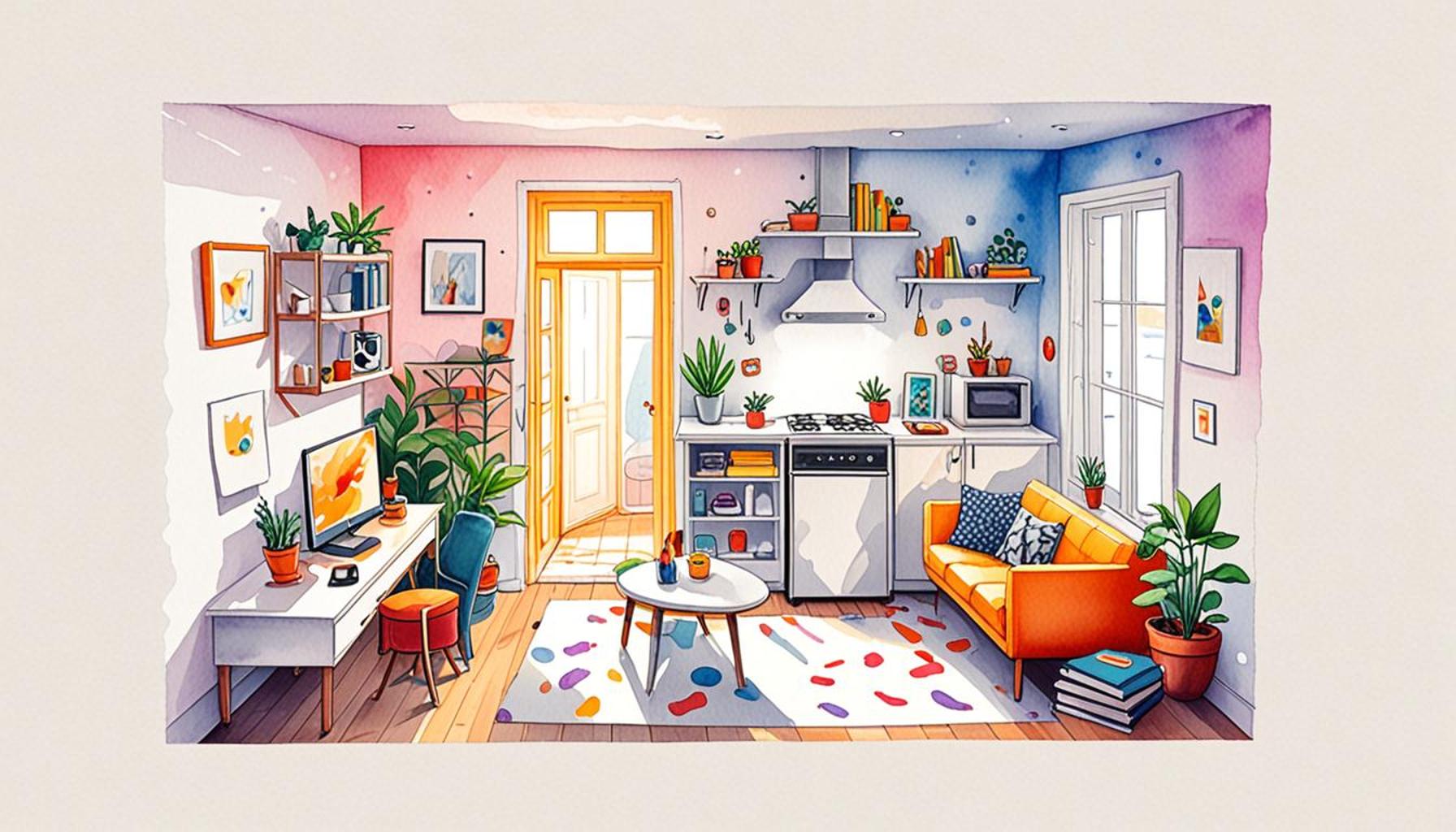Functional Organization: How Minimalism Influences Space Optimization in Home Offices

Embracing Change in Your Workspace
As the landscape of work continues to shift, the traditional office setting is gradually being replaced by the comforts of home. This shift calls for transformation not only in routine but also in how we perceive and organize our spaces. The principle of minimalism emerges as an invaluable ally, reshaping how we can construct environments that inspire focus, creativity, and productivity.
Core Elements of Minimalism in Home Offices
At the heart of minimalist design lies the idea that less is more. Implementing this concept in a home office can yield significant benefits, both psychologically and functionally. Here are a few pivotal features that can enhance your workspace:
- Decluttered Spaces: The presence of fewer items promotes a clear mind and a streamlined workflow. By removing unnecessary objects, including gadgets or decor that do not serve a purpose, individuals can create a peaceful environment that encourages concentration. Consider using just one or two framed photos instead of multiple frames scattered around, creating a refined focal point without overwhelming the senses.
- Multi-functional Furniture: Investing in furniture that serves more than one purpose can transform the functionality of a minimalist home office. For example, a desk with built-in storage can reduce the need for additional shelving, while a foldable chair can free up space when not in use. This not only maximizes utility but also fosters a flexible environment where adjustments can be made as needed.
- Neutral Color Palettes: Soft, calming colors such as whites, beiges, or pastel shades can create a serene backdrop that enhances focus. These hues reflect light and can make a space feel larger and more inviting. Choosing a neutral palette allows for a visually cohesive room, minimizing distractions that might arise from clashing colors or excessive patterns.
The Impact of Functional Organization
While aesthetic appeal is an integral part of a minimalistic office, functional organization is critical to its effectiveness. The goal is to create a workspace that caters to personal needs while remaining uncluttered. For instance, adopting a simple filing system—using labeled folders or digital storage—can streamline document management. Additionally, keeping frequently used tools within arm’s reach, yet neatly contained, can prevent chaos.
Embracing a minimalist approach not only maximizes physical space but can also foster a sense of mental clarity. The absence of unnecessary distractions allows for greater focus, leading to improved productivity over time. Through the integration of minimalist principles, individuals can curate a workspace that not only reflects their personal style but also enhances overall work performance.
In exploring how minimalism can revolutionize the home office setup, consider this approach not merely as a trend but as a sustainable lifestyle choice. Adopting a simpler way of living can lead to profound benefits, from reduced stress to increased efficiency. Step into a world where your workspace is a reflection of purpose and clarity—an environment that harmonizes with your workflow and encourages creativity.

DIVE DEEPER: Click here to discover the benefits of emotional decluttering
Rethinking Your Home Office with Minimalism
To truly embrace minimalism in your home office, it’s essential to rethink not only the space itself but also the fundamental principles guiding your approach to functionality. Minimalism is not just about having fewer things; it’s about aligning your space with your goals and creating an environment conducive to productivity. By recognizing the interplay between functional organization and minimalism, individuals can design an office that not only looks streamlined but operates efficiently.
Strategic Organization: A Key Component
Effective organization begins with identifying the core components of your workspace and how they relate to your workflow. When you strip away the distractions, you are left with what matters most: your ability to work effectively. Here are some strategies to incorporate into your minimalist home office:
- Zone Layout: Creating distinct zones within your office can greatly enhance organization. For example, designate specific areas for focused work, collaboration, and storage. This provides a clear structure that encourages movement and delineates purpose, making it easier to switch between tasks without confusion.
- Essential Tools Only: Limit the items on your desk to only those that you use regularly. This could include your computer, a notebook, and a couple of pens. By minimizing the presence of tools that are rarely used, you can foster a cleaner aesthetic and reduce visual noise.
- Vertical Space Utilization: Don’t disregard vertical space in your home office. Wall-mounted shelves or pegboards can hold supplies, decor, or inspiration boards while keeping surfaces clear. This not only frees up desk space but also creates a modern look that aligns with minimalist principles.
As you implement these strategies, consider how each choice impacts your ability to work efficiently. The principle of functional organization encourages you to eliminate redundancy—no duplicate tools or excessive furniture. Opting for pieces that serve a dual purpose can help as well. For instance, a bookcase with a workspace below allows you to store materials efficiently while still having a dedicated work area.
When everything has its place, the likelihood of distraction decreases. The typical clutter that can build up in a home office not only impacts the physical space but can also detract from your mental clarity and focus. By prioritizing functional organization within a minimalist framework, you can harness a clearer mind that is better suited for creative and productive endeavors.
In this way, minimalism influences the optimization of space in your home office by compelling you to reconsider every element within your environment. It invites you to seek solutions that promote ease of use while reflecting a design ethos that is clean and effective. Ultimately, making these changes can lead to a workspace where functionality meets tranquility, creating a refuge from the chaos that can often accompany remote work.
Functional Organization: How Minimalism Influences Space Optimization in Home Offices
As the shift towards remote work continues, the need for a well-organized, functional home office has never been more apparent. Minimalism plays a pivotal role in shaping this environment. By reducing clutter and focusing on essential items, a minimalist approach not only enhances productivity but also optimizes the use of available space.
When implementing a minimalist design in a home office, consider the following principles:
- Declutter Regularly: Remove non-essential items that can distract you from your work. Regularly assessing what is needed will help maintain an orderly environment.
- Multi-Functional Furniture: Invest in versatile pieces, such as desks that offer built-in storage. This helps reduce visual clutter while providing ample organizational options.
- Designate Zones: Create separate areas within your office for different tasks, using minimal furnishings to delineate these spaces. This improves both focus and workflow.
- Effective Lighting: Utilize natural light whenever possible, and incorporate minimal lighting solutions that complement the workspace without overpowering it.
By embracing these strategies, you can create a home office that not only promotes productivity but also reflects a chic and sophisticated atmosphere. Moreover, a minimalist space instills a sense of calm and clarity, allowing your mind to focus on what truly matters—your work.
For those interested in creating such environments, exploring the philosophy of minimalism can lead to a deeper understanding of how thoughtful design directly influences both mental well-being and efficiency. Consider how a well-organized space can serve not only as a backdrop for your work but also as a catalyst for creativity and innovation.
| Advantages of Minimalism | Description |
|---|---|
| Reduced Clutter | A decluttered space enables enhanced focus and efficiency. |
| Enhanced Productivity | Minimalism promotes an environment that fosters creativity and innovation. |
These advantages illustrate how applying a minimalist framework can significantly improve the functionality and aesthetic appeal of home offices. By prioritizing essential elements, individuals can create a workspace that not only facilitates work but enriches their remote work experience overall.
DISCOVER MORE: Click here for effective decluttering strategies
Creating a Calming Atmosphere with Minimalist Design
A minimalist home office doesn’t just promote organization; it also fosters a calming atmosphere that can considerably enhance productivity. The principles of functional organization embrace simplicity, leading to a space where distractions are minimized and focus is amplified. Let’s explore how design elements and color choices contribute to this serene environment.
Color Theory and Its Impact
The colors you choose for your home office can dramatically affect your mood and productivity levels. Minimalism often champions neutral tones—whites, grays, and soft earth colors—creating an open, airy feel. Such hues not only reflect light, making the space feel larger but also serve to create a peaceful backdrop for your daily activities. Incorporating splashes of accent colors—such as calming blues or invigorating greens—can help to stimulate creativity while maintaining a fundamentally minimalist look.
Natural Elements: Bringing the Outside In
Integrating natural elements into your home office can also enhance both aesthetics and well-being. Consider adding a few low-maintenance plants, such as succulents or snake plants, to improve air quality and provide visual interest. These elements can enhance your workspace without overwhelming it, reminding you of nature’s tranquility amidst a potentially stressful workday. Furthermore, bringing in natural light is crucial; positioning your desk near a window can not only boost your mood but also improve concentration.
Furniture Choices: Functionality Meets Style
When selecting furniture, prioritize pieces that offer both functionality and a sleek design. Choose a desk that suits your work habits while providing ample storage solutions. Look for models with built-in drawers or compartments to keep essential supplies hidden, further reinforcing the minimalist ethos. Ergonomic chairs should not only be functional but also contribute to the overall aesthetic of your space. Sustaining comfort is essential, especially for those long hours spent in front of the computer.
Don’t overlook the importance of technology and cords. Keeping cables neatly organized and out of sight contributes to a streamlined workspace. Tools such as cable trays or cord organizers help achieve a clutter-free desktop, emphasizing the clean lines that are synonymous with minimalism.
Decluttering as a Regular Practice
Even in a well-organized minimalist office, clutter can creep back in. It’s essential to adopt decluttering practices regularly—perhaps conducting a monthly or even weekly assessment of your space to determine what is truly necessary. Use this time to remove items that no longer serve your purpose or have not been used in recent memory. This not only frees up physical space but also refreshes your mental landscape, allowing creativity to flow freely.
By applying these principles rooted in functional organization, your home office can transform into a peaceful haven that not only maximizes space but elevates your potential for productivity. Minimalism guides you to make intentional choices that encourage a clean, functional environment focused squarely on your work objectives.
DISCOVER MORE: Click here to enhance your productivity
Final Thoughts on Functional Organization and Minimalism in Home Offices
In conclusion, the intersection of functional organization and minimalism offers a transformative approach to creating a highly efficient home office. By emphasizing simplicity, mindfulness, and intentionality in design and layout, individuals can cultivate an environment that not only maximizes physical space but also enhances mental clarity and productivity. The thoughtful incorporation of neutral color palettes and natural elements promotes a calming atmosphere, while the strategic selection of multifunctional furniture ensures that every item serves a purpose.
The practice of regular decluttering is vital; it empowers individuals to maintain a clean and focused workspace, essential for navigating the challenges of remote work or freelance projects. Embracing minimalism allows for the reduction of distractions, ultimately fostering a sanctuary where creativity thrives and work objectives can be pursued effectively.
As the trend of working from home continues to rise, there is a compelling need for individuals to rethink their office spaces. By prioritizing space optimization, anyone can create a home office that not only meets their functional needs but also promotes well-being and productivity. The principles of minimalism provide a valuable framework for reimagining workspaces across the United States, making them not just a place to work, but a place to thrive. Therefore, consider embarking on your minimalism journey today, and witness firsthand the profound impact it can have on your work life.


